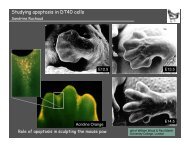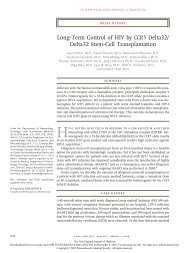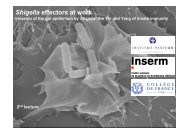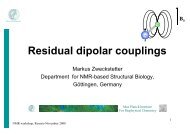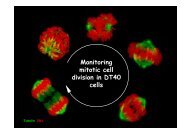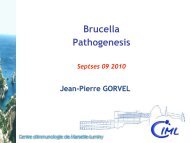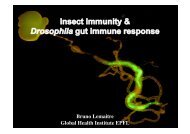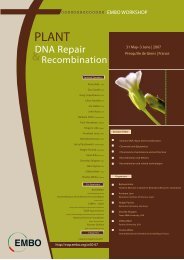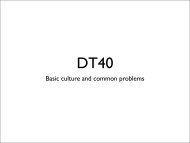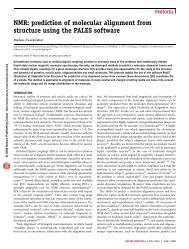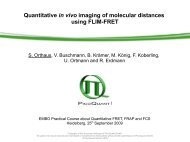28 Martin Clin Vac Immunol 2006 - Events
28 Martin Clin Vac Immunol 2006 - Events
28 Martin Clin Vac Immunol 2006 - Events
Create successful ePaper yourself
Turn your PDF publications into a flip-book with our unique Google optimized e-Paper software.
CLINICAL AND VACCINE IMMUNOLOGY, Nov. <strong>2006</strong>, p. 1267–1277 Vol. 13, No. 11<br />
1556-6811/06/$08.000 doi:10.11<strong>28</strong>/CVI.00162-06<br />
A DNA <strong>Vac</strong>cine for Ebola Virus Is Safe and Immunogenic in a Phase<br />
I <strong>Clin</strong>ical Trial †<br />
Julie E. <strong>Martin</strong>, 1 Nancy J. Sullivan, 1 Mary E. Enama, 1 Ingelise J. Gordon, 1 Mario Roederer, 1<br />
Richard A. Koup, 1 Robert T. Bailer, 1 Bimal K. Chakrabarti, 1 Michael A. Bailey, 1<br />
Phillip L. Gomez, 1 Charla A. Andrews, 1 Zoe Moodie, 2 Lin Gu, 2<br />
Judith A. Stein, 1 Gary J. Nabel, 1 Barney S. Graham, 1 *<br />
and the VRC 204 Study Team 1 ‡<br />
<strong>Vac</strong>cine Research Center, National Institute of Allergy and Infectious Diseases, National Institutes of Health, 40 Convent Drive,<br />
Bethesda, Maryland 20892-3017, 1 and Statistical Center for HIV/AIDS Research and Prevention,<br />
Fred Hutchinson Cancer Research Center, Seattle, Washington 98109-1024 2<br />
Received 2 May <strong>2006</strong>/Returned for modification 9 June <strong>2006</strong>/Accepted 20 August <strong>2006</strong><br />
Ebola viruses represent a class of filoviruses that causes severe hemorrhagic fever with high mortality.<br />
Recognized first in 1976 in the Democratic Republic of Congo, outbreaks continue to occur in equatorial Africa.<br />
A safe and effective Ebola virus vaccine is needed because of its continued emergence and its potential for use<br />
for biodefense. We report the safety and immunogenicity of an Ebola virus vaccine in its first phase I human<br />
study. A three-plasmid DNA vaccine encoding the envelope glycoproteins (GP) from the Zaire and Sudan/Gulu<br />
species as well as the nucleoprotein was evaluated in a randomized, placebo-controlled, double-blinded, dose<br />
escalation study. Healthy adults, ages 18 to 44 years, were randomized to receive three injections of vaccine at<br />
2mg(n 5),4mg(n 8),or8mg(n 8) or placebo (n 6). Immunogenicity was assessed by enzyme-linked<br />
immunosorbent assay (ELISA), immunoprecipitation-Western blotting, intracellular cytokine staining (ICS),<br />
and enzyme-linked immunospot assay. The vaccine was well-tolerated, with no significant adverse events or<br />
coagulation abnormalities. Specific antibody responses to at least one of the three antigens encoded by the vaccine<br />
as assessed by ELISA and CD4 T-cell GP-specific responses as assessed by ICS were detected in 20/20 vaccinees.<br />
CD8 T-cell GP-specific responses were detected by ICS assay in 6/20 vaccinees. This Ebola virus DNA vaccine was<br />
safe and immunogenic in humans. Further assessment of the DNA platform alone and in combination with<br />
replication-defective adenoviral vector vaccines, in concert with challenge and immune data from nonhuman<br />
primates, will facilitate evaluation and potential licensure of an Ebola virus vaccine under the Animal Rule.<br />
Outbreaks of infection with Ebola virus result in a rapid and<br />
severe disease with high mortality, for which there is currently<br />
no licensed antiviral treatment or vaccine. While outbreaks<br />
remain unpredictable, they have occurred with increasing frequency<br />
in equatorial Africa, west of the Rift Valley, where they<br />
have infected both humans and nonhuman primates and have<br />
significantly depleted chimpanzee and gorilla populations in<br />
Central Africa. Although a potential reservoir has been suggested<br />
(15), the risk of zoonotic transmission remains high and<br />
unpredictable (1). Announcements of Ebola virus outbreaks<br />
cause widespread fear and have socioeconomic consequences<br />
beyond the direct impact on infected persons. Outbreaks of<br />
* Corresponding author. Mailing address: <strong>Vac</strong>cine Research Center,<br />
NIAID/NIH, 40 Convent Drive, MSC-3017, Room 2502, Bethesda,<br />
MD 20892-3017. Phone: (301) 594-8468. Fax: (301) 480-2771. E-mail:<br />
bgraham@nih.gov.<br />
† Supplemental material for this article may be found at http://cvi<br />
.asm.org/.<br />
‡ The VRC 204 Study Team includes Margaret M. McCluskey,<br />
Brenda Larkin, Sarah Hubka, Lasonji Holman, Laura Novik, Pamela<br />
Edmonds, Steve Rucker, Michael Scott, Colleen Thomas, LaChonne<br />
Stanford, Ed Tramont, Woody Dubois, Tiffany Alley, Erica Eaton,<br />
Sandra Sitar, Ericka Thompson, Andrew Catanzaro, Joseph Casazza,<br />
Janie Parrino, Laurence Lemiale, Rebecca Sheets, Ellen Turk, Laurie<br />
Lamoreaux, Jennifer Fischer, Mara Abashian, John Rathmann, and<br />
Adrienne McNeil.<br />
Published ahead of print on 20 September <strong>2006</strong>.<br />
1267<br />
Ebola virus infection have become more frequent since its<br />
discovery in 1976 and reemergence in 1995, and there are now<br />
areas in which the infection appears to be endemic. Although<br />
there have been no human outbreaks of Ebola virus in the<br />
United States, the virus caused an outbreak in imported laboratory<br />
nonhuman primates in Reston, Va., in 1989. It is also<br />
considered to be a potential bioweapon. For these reasons,<br />
vaccine development for Ebola virus and other filoviruses has<br />
become a priority.<br />
Outbreaks of hemorrhagic fever caused by the Ebola virus<br />
are associated with high mortality rates. The highest lethality is<br />
associated with the Zaire subtype, one of four species identified<br />
to date (9, 21). An outbreak of hemorrhagic fever reported<br />
in October 2000 in the Gulu district of Uganda was confirmed<br />
as Ebola virus and resulted in the deaths of dozens of people<br />
(6). Another outbreak in Gabon and the Republic of Congo<br />
likely involved several independent introductions. It continued<br />
from 2001 through 2003 and resulted in more than 100 deaths<br />
(3, <strong>28</strong>). The triggers for such outbreaks are not understood,<br />
although there may be a correlation with climatic changes (31).<br />
These periodic but devastating outbreaks underscore the difficulty<br />
in controlling this virus that emerges periodically via<br />
uncertain primary transmission routes and then disappears<br />
into an unclearly defined natural reservoir.<br />
Infection with Ebola virus initially results in an influenza-like<br />
syndrome that progresses to severe illness manifested by co-<br />
Downloaded from<br />
cvi.asm.org at UNIVERSITAETSSPITAL on May 20, 2010
1268 MARTIN ET AL. CLIN. VACCINE IMMUNOL.<br />
agulation abnormalities, disseminated intravascular coagulation,<br />
multi-organ system involvement, and an exaggerated but<br />
nonprotective inflammatory response (1). Fatality rates range<br />
from 50 to 90%, and death is frequently due to bleeding and<br />
hypotensive shock (22). The rapid advancement of severe disease<br />
following Ebola virus infection allows little opportunity to<br />
develop natural immunity, and there is no effective antiviral<br />
therapy currently available. <strong>Vac</strong>cination offers a propitious intervention<br />
to prevent infection and limit spread as well as an<br />
important public health benefit for health care workers involved<br />
in care of patients and the containment of outbreaks.<br />
Because of the potential safety concerns associated with<br />
using conventional vaccination strategies, such as attenuated<br />
or inactivated Ebola virus as an immunogen, the vaccination<br />
strategies that have been evaluated in published preclinical<br />
studies to date for Ebola virus have focused on the use of live<br />
and replication-defective vectors and virus-like particles. Published<br />
studies have included expression of Ebola virus protein<br />
subunits in live vaccinia virus vectors, selected DNA plasmids,<br />
Ebola virus-like particles, replication-competent vesicular stomatitis<br />
virus, Venezuela equine encephalitis virus replicons,<br />
recombinant parainfluenza virus type 3, replication-defective<br />
recombinant adenovirus (rAd), and DNA combined with rAd<br />
prime-boost strategies (5, 12, 14, 19, 22, 24, 26, 31). While<br />
many of these approaches have been evaluated in a nonhuman<br />
primate model (10), only DNA/rAd-, rAd-, or vesicular stomatitis<br />
virus-based vaccines have shown efficacy in primates.<br />
DNA vaccination conferred an Ebola virus-specific immune<br />
response in guinea pigs and mice (4, 25, 32) that protected<br />
against a challenge with Ebola virus adapted to produce lethal<br />
infection in rodents (1, 4, 8). Humoral and T-cell-mediated<br />
immunity were elicited in these animal models, but antibody<br />
titers appeared to correlate better with protection following<br />
immunization with plasmids carrying genes for Ebola virus<br />
Zaire proteins. DNA vaccination followed by a boost with<br />
recombinant adenoviral vectors encoding Ebola viral proteins<br />
uniformly protected nonhuman primates from an otherwiselethal<br />
dose of Ebola virus (25). Protection correlated with the<br />
development of Ebola virus-specific CD8 T-cell and antibody<br />
production. The vaccinated animals remained protected and<br />
asymptomatic following challenge with a lethal dose of the<br />
highly pathogenic, wild-type, 1976 Mayinga strain of Ebola<br />
virus Zaire (22, 24, 25).<br />
Ideally, an effective vaccine would provide immunity to the<br />
multiple Ebola virus species that have been isolated in human<br />
infections and may require multiple antigenic specificities.<br />
There is a concern that combining multiple expression vectors<br />
in the same vaccine may result in interference of expression of<br />
some of the constructs (23). However, a multigene vaccine<br />
containing antigens for Ebola virus glycoproteins from the<br />
Zaire, Ivory Coast, and Sudan viruses induced specific immune<br />
responses to all three subtypes without evidence of interference<br />
in an animal model (24, 25). Additionally, a series of<br />
studies showed that both GP and sGP (a soluble form of the<br />
glycoprotein) conferred optimal protection in the guinea pig<br />
model (25, 32). We report the results of the first human clinical<br />
trial of a candidate Ebola virus DNA vaccine and show that<br />
plasmids expressing Ebola virus GP (Zaire [Z]), GP (Sudan/<br />
Gulu [S/G]), and NP (Z) are safe and well-tolerated and in-<br />
duce Ebola virus-specific antibody and T-cell responses in<br />
healthy adults.<br />
MATERIALS AND METHODS<br />
Study design. Protocol VRC 204 was a single-site, phase I, randomized, placebo-controlled,<br />
double-blinded, dose escalation study to examine safety and<br />
tolerability, dose, and immune response to an investigational Ebola virus plasmid<br />
DNA vaccine. Healthy adult volunteers 18 to 44 years of age were recruited at<br />
the NIAID <strong>Vac</strong>cine Research Center <strong>Clin</strong>ic, National Institutes of Health (Bethesda,<br />
Md.). Human experimental guidelines of the U.S. Department of Health<br />
and Human Services were followed in the conduct of clinical research, and the<br />
protocol was reviewed and approved by the National Institute of Allergy and<br />
Infectious Diseases (NIAID) Institutional Review Board. Three sequential<br />
groups of volunteers were enrolled between November 2003 and July 2004 to<br />
receive placebo or vaccine at doses of 2.0 mg, 4.0 mg, and 8.0 mg, respectively.<br />
Group 1 subjects (n 7) were randomized in a ratio of 5 vaccine/2 placebo;<br />
group 2 (n 10) and group 3 (n 10) subjects were randomized in a ratio of 8<br />
vaccine/2 placebo. Total enrollment was 27 volunteers (21 vaccine, 6 placebo). In<br />
all groups, the vaccine was administered on study days 0, <strong>28</strong> 7, and 56 7 (with<br />
at least 21 days between injection days).<br />
Safety through at least 2 weeks after the second injection at each dose level<br />
was reviewed by a data and safety monitoring board prior to enrolling volunteers<br />
into the next dose level group. For the 2.0-mg and 4.0-mg immunizations, a single<br />
dose of vaccine or placebo required a volume of 1.0 ml, administered by intramuscular<br />
injection in the lateral deltoid muscle. The maximum concentration of<br />
vaccine formulation is 4 mg/ml; therefore, two 1.0-ml injections (one intramuscular<br />
injection in each deltoid muscle) of this formulation were necessary to<br />
deliver the 8.0-mg dose. Placebo was administered the same way as vaccine for<br />
each dosage group. All intramuscular injections were administered with the<br />
Biojector 2000 needle-free injection management system. Adverse reactions<br />
were evaluated by laboratory and clinical evaluations at scheduled study visits,<br />
coded using the Medical Dictionary for Regulatory Activities, and severity graded<br />
using a scale of 0 to 5. Solicited reactogenicity was collected by study subject<br />
report on 7-day diary cards. Subjects were followed for a total of 12 months, and<br />
the study was completed in August 2005.<br />
<strong>Vac</strong>cine. This multigene plasmid DNA vaccine is a mixture of three plasmids<br />
in equal concentrations that were constructed to produce three Ebola virus<br />
proteins designed to elicit broad immune responses to multiple Ebola virus<br />
subtypes. These proteins include the nucleoprotein (NP) derived from the Zaire<br />
strain of Ebola virus, which exhibits highly conserved domains, as well as two<br />
glycoproteins (GP), which mediate viral entry, from the Zaire strain (homologous<br />
to the Ivory Coast strain) and the Sudan/Gulu species (associated with<br />
recent outbreaks of hemorrhagic fever in Africa). The Ebola virus GP genes<br />
expressed by plasmid DNA constructs in this vaccine contain deletions in the<br />
transmembrane region of GP that were intended to eliminate potential cellular<br />
toxicity observed in the in vitro experiments using plasmids expressing the fulllength<br />
wild-type GPs (33). In addition, the Ebola virus GP inserts have been modified<br />
to optimize expression in human cells. The three plasmids in this vaccine are<br />
incapable of replication in animal cells and would not permit the generation of an<br />
infectious virion even if recombination or gene duplication were to occur.<br />
The vaccine plasmids were prepared by cloning the Ebola virus gene sequences<br />
into the VR-1012 expression vector produced by Vical, Inc. (San Diego, CA)<br />
(13). The VR-1012 expression vector is very similar to the vector backbone used<br />
in a plasmid DNA-based malaria vaccine (29) and a multiclade human immunodeficiency<br />
virus (HIV) DNA vaccine that has been tested in humans (11). To<br />
generate the vaccine (EBODNA012-00-VP) tested in this clinical trial, Ebola<br />
virus GP gene sequences were subcloned into a slightly modified VR-1012<br />
plasmid backbone containing the human T-cell leukemia virus 1 R region translational<br />
enhancer for improved expression (2). The CMV/R expression vector<br />
has been tested in a clinical trial of a multiclade HIV DNA vaccine (11) and in<br />
other candidate vaccines currently undergoing evaluation in clinical studies by<br />
the <strong>Vac</strong>cine Research Center and the Division of AIDS, NIAID, National<br />
Institutes of Health.<br />
The DNA plasmids were produced in bacterial cell cultures containing a<br />
kanamycin selection medium. The process involved Escherichia coli fermentation,<br />
purification, and formulation as a sterile liquid injectable dosage form for<br />
intramuscular injection. Following growth of bacterial cells harboring the plasmid,<br />
the plasmid DNA was purified from cellular components.<br />
The vaccine was produced by Vical, Inc. (San Diego, CA), under current Good<br />
Manufacturing Practices conditions and met lot release specifications prior to<br />
administration. This naked DNA product involves no lipid, viral, or cellular<br />
vector components. A phosphate-buffered saline placebo control, pH 7.2, was<br />
Downloaded from<br />
cvi.asm.org at UNIVERSITAETSSPITAL on May 20, 2010
VOL. 13, <strong>2006</strong> PHASE I CLINICAL TRIAL OF EBOLA DNA VACCINE 1269<br />
Characteristic and subcategory<br />
produced under current Good Manufacturing Practices conditions by Bell-More<br />
Labs, Inc. (Hampstead, MD).<br />
Measurement of antibody responses: enzyme-linked immunosorbent assay<br />
(ELISA). Endpoint titers of antibodies directed against Ebola virus antigens NP<br />
(Z), GP (S/G), and GP (Z) were determined using 96-well Immulon 2 plates<br />
(Dynex Technologies) coated with a preparation of purified recombinant proteins<br />
according to methods adapted from those described previously (11). Biotinlabeled<br />
anti-human immunoglobulin G (IgG), IgA, or IgM and streptavidin<br />
conjugated with horseradish peroxidase and 3,5,5,5-tetramethylbenzidine substrate<br />
was used to develop the reaction, which was detected on a Spectramax<br />
microplate spectrophotometer (Molecular Devices, Sunnyvale, CA). The endpoint<br />
titer was calculated as the most dilute serum concentration that gave an<br />
optical density reading of 0.2 above background.<br />
Measurement of antibody responses by immunoprecipitation and Western<br />
blot analysis. Antibody responses were measured in a semiquantitative assay<br />
combining immunoprecipitation (IP) of crude cell-free supernatants containing<br />
GP (Z) or GP (S/G) or cell lysates containing NP protein with volunteer sera,<br />
followed by Western blotting for GP or NP as previously described (7). Briefly,<br />
sera (10 l) from immunized individuals were used to immunoprecipitate Ebola<br />
virus proteins either from 100 l of cell-free supernatant or from cell lysates of<br />
293 cells (100 l of cell lysate is equivalent to 300 to 400 g of total protein)<br />
transfected with vectors encoding transmembrane-deleted Ebola virus GP (Z) or<br />
transmembrane-deleted Ebola virus GP (S/G) or Ebola virus NP (Z). Immune<br />
complexes were separated by sodium dodecyl sulfate–7.5% polyacrylamide gel<br />
electrophoresis (SDS-PAGE) and analyzed by immunoblotting using the following<br />
Ebola virus protein-specific antibodies: mouse monoclonal 12B5 (generous<br />
TABLE 1. Demographic characteristics at enrollment<br />
No. (%) of subjects with characteristic in dose group<br />
2mg(n 5) 4mg(n 8) 8mg(n 8) Placebo (n 6) Overall (n 27)<br />
Gender<br />
Male 5 (100.0) 5 (62.5) 5 (62.5) 3 (50.0) 18 (66.7)<br />
Female 0 (0.0) 3 (37.5) 3 (37.5) 3 (50.0) 9 (33.3)<br />
Age a (yrs)<br />
18–20 0 (0.0) 0 (0.0) 1 (12.5) 0 (0.0) 1 (3.7)<br />
21–30 1 (20.0) 3 (37.5) 3 (37.5) 0 (0.0) 7 (25.9)<br />
31–44 4 (80.0) 5 (62.5) 4 (50.0) 6 (100.0) 19 (70.4)<br />
Mean (SD) 34.0 (6.4) 36.4 (8.8) <strong>28</strong>.3 (8.4) 34.7 (1.9) 33.1 (7.6)<br />
Range 24–41 24–44 18–43 32–37 18–44<br />
Race<br />
White 5 (100.0) 8 (100.0) 7 (87.5) 6 (100.0) 26 (96.3)<br />
Black or African American 0 (0.0) 0 (0.0) 1 (12.5) 0 (0.0) 1 (3.7)<br />
Asian 0 (0.0) 0 (0.0) 0 (0.0) 0 (0.0) 0 (0.0)<br />
American Indian/Alaskan Native 0 (0.0) 0 (0.0) 0 (0.0) 0 (0.0) 0 (0.0)<br />
Native Hawaiian or other Pacific Islander 0 (0.0) 0 (0.0) 0 (0.0) 0 (0.0) 0 (0.0)<br />
Multiracial 0 (0.0) 0 (0.0) 0 (0.0) 0 (0.0) 0 (0.0)<br />
Other/unknown 0 (0.0) 0 (0.0) 0 (0.0) 0 (0.0) 0 (0.0)<br />
Ethnicity<br />
Non-Hispanic/Latino 5 (100.0) 8 (100.0) 8 (100.0) 5 (83.3) 26 (96.3)<br />
Hispanic/Latino 0 (0.0) 0 (0.0) 0 (0.0) 1 (16.7) 1 (3.7)<br />
BMI b<br />
Under 18.5 0 (0.0) 0 (0.0) 0 (0.0) 0 (0.0) 0 (0.0)<br />
18.5–24.9 4 (80.0) 6 (75.0) 3 (37.5) 3 (50.0) 16 (59.3)<br />
25.0–29.9 0 (0.0) 1 (12.5) 3 (37.5) 2 (33.3) 6 (22.2)<br />
30.0 or over 1 (20.0) 1 (12.5) 2 (25.0) 1 (16.7) 5 (18.5)<br />
Mean (SD) 23.0 (4.0) 25.8 (7.1) 27.0 (7.9) 25.5 (5.3) 25.6 (6.4)<br />
Range 20.1–30.1 21.0–42.2 19.5–39.2 20.6–34.7 19.5–42.2<br />
Education<br />
Less than high school graduate 0 (0.0) 0 (0.0) 0 (0.0) 0 (0.0) 0 (0.0)<br />
High school graduate/GED 1 (20.0) 2 (25.0) 2 (25.0) 0 (0.0) 5 (18.5)<br />
College/university 3 (60.0) 3 (37.5) 5 (62.5) 2 (33.3) 13 (48.1)<br />
Advanced degree 1 (20.0) 3 (37.5) 1 (12.5) 4 (66.7) 9 (33.3)<br />
a Age at enrollment day.<br />
b Height and weight (used for BMI) were from the screening evaluation.<br />
gift from Mary Kate Hart, USAMRIID) against GP (Z), rabbit polyclonal B83<br />
(generous gift from Barton Haynes, Duke University) against GP (S/G), or<br />
mouse monoclonal 1C9 (generous gift from Barton Haynes, Duke University)<br />
against NP. Preimmune sera (10 l) from those individuals were used as controls.<br />
The gels were scanned, and the intensity of each band was quantified by densitometry<br />
using the program ImageQuant; results are presented graphically to<br />
facilitate comparisons among groups.<br />
Measurement of T-cell responses and cell preparation. Peripheral blood<br />
mononuclear cells (PBMC) were prepared by standard Ficoll-Hypaque density<br />
gradient centrifugation (Pharmacia, Uppsala, Sweden). PBMC were frozen in<br />
heat-inactivated fetal calf serum containing 10% dimethyl sulfoxide in a Forma<br />
CryoMed cell freezer (Marietta, OH). Cells were stored at 140°C. All immunogenicity<br />
assays were performed on thawed specimens; average viability was<br />
95%.<br />
Antibodies. Unconjugated mouse anti-human CD<strong>28</strong>, unconjugated mouse antihuman<br />
CD49d, allophycocyanin-conjugated mouse anti-human CD3, fluorescein<br />
isothiocyanate-conjugated mouse anti-human CD8, peridinin chlorophyll protein-conjugated<br />
mouse anti-human CD4, and a mixture of phycoerythrin-conjugated<br />
mouse anti-human gamma interferon (IFN-) and interleukin 2 (IL-2)<br />
monoclonal antibodies were obtained from Becton Dickinson Immunocytometry<br />
Systems (BDIS; San Jose, CA). All reagents were independently titrated to<br />
determine the optimum concentrations for staining.<br />
Peptides and cell stimulation. Peptides 15 amino acids in length, overlapping<br />
by 11, and corresponding to the vaccine inserts were synthesized at 85% purity<br />
as confirmed by high-performance liquid chromatography (24). Peptides were<br />
pooled for each protein, NP (Z), GP (S/G), and GP (Z), and used at a final<br />
Downloaded from<br />
cvi.asm.org at UNIVERSITAETSSPITAL on May 20, 2010
1270 MARTIN ET AL. CLIN. VACCINE IMMUNOL.<br />
concentration of 500 ng per stimulation. Cell stimulation was performed as<br />
described previously (11). Briefly, one million PBMC in 200 l R-10 medium<br />
(RPMI 1640 supplemented with 10% heat-inactivated fetal bovine serum, 100<br />
U/ml penicillin G, 100 g/ml streptomycin sulfate, and 1.7 mM sodium glutamate)<br />
were incubated with 1 g/ml each of costimulatory anti-CD<strong>28</strong> and -CD49d<br />
monoclonal antibodies and 2.5 g/ml of each peptide in wells of 96-well Vbottom<br />
plates. Cells incubated with only costimulatory antibodies were included<br />
in every experiment to control for spontaneous production of cytokine and<br />
activation of cells prior to addition of peptides. Staphylococcal enterotoxin B (10<br />
g/ml; Sigma-Aldrich) was used as a positive control for lymphocyte activation.<br />
Cultures were incubated at 37°C in a 5% CO 2 incubator for 6hinthepresence<br />
of brefeldin A (10 g/ml; Sigma, St. Louis, MO).<br />
Intracellular cytokine and immunofluorescence staining. Cells were permeabilized<br />
for 7 min in 200 l of a solution containing 67 l Tween 20 (Sigma), 106<br />
l deionized water, and 27 l of10 FACS-Lyse solution (BDIS) at room<br />
temperature, washed twice in cold Dulbecco’s phosphate-buffered saline containing<br />
1% fetal bovine serum and 0.02% sodium azide (FACS [fluorescenceactivated<br />
cell sorting] buffer), and stained directly with conjugated anti-human<br />
CD3, anti-human CD4, anti-human CD8, and anti-human IFN- and IL-2 antibodies<br />
for 15 min on ice. Stained cells were then immediately washed twice with<br />
cold FACS buffer. The cells were resuspended in Dulbecco’s phosphate-buffered<br />
saline containing 1% paraformaldehyde (Electron Microscopy Systems, Fort<br />
Washington, PA) and stored at 4°C until analysis. Four-parameter flow cytometric<br />
analysis was performed on a FACSCalibur flow cytometer (BDIS). Following<br />
intracellular cytokine staining (ICS), between 50,000 and 250,000 events were<br />
acquired, gated on small lymphocytes, and assessed for CD3, CD8, CD4, and<br />
IFN-/IL-2 expression. Results were analyzed using FlowJo software (Tree Star<br />
Software, Ashland, OR). The same cytokine, CD4, and CD8 gates were used for<br />
the entire trial.<br />
ELISPOT. <strong>Vac</strong>cine-induced T-cell responses were also detected by enzymelinked<br />
immunospot assays (ELISPOT) according to a modification of previously<br />
published methods (11) using a commercially available ELISPOT kit (BD Biosciences).<br />
PBMC were stimulated overnight at 37°C in triplicate wells at a density<br />
of 2 10 5 cells/well for all stimulations other than staphylococcal enterotoxin B,<br />
which was conducted at 5 10 4 cells/well. Following incubation, cells were lysed,<br />
and the wells were washed and incubated for 2hatroom temperature in the<br />
presence of biotinylated IFN- detection antibodies. Subsequently, the wells<br />
were incubated with an avidin-horseradish peroxidase solution for 1hatroom<br />
temperature, followed by a 20-min incubation with the AEC substrate solution.<br />
The plate was air dried for a minimum of 2 hours prior to spot quantitation on<br />
a CTL ELISPOT image analyzer (Cellular Technology Ltd., Cleveland, OH).<br />
Results were expressed as mean spot-forming cells per million PBMC.<br />
Statistical methods. Positive response rates to any antigen (GP [S/G], GP [Z],<br />
or NP [Z]) and to each individual antigen were used to summarize the T-cell<br />
response data; exact two-sided 95% confidence intervals (29) are reported. The<br />
positivity criteria for the ICS data consisted of a statistical hypothesis test for a<br />
difference in the stimulated and unstimulated wells followed by the requirement<br />
of a minimal level of response. For an individual’s response to be categorized as<br />
positive, it had to be statistically significant and had to exceed the threshold for<br />
positivity. Positivity thresholds were based on an ICS validation study of HIV<br />
peptides completed at the VRC. The thresholds were selected to give a 1%<br />
false-positive rate across PBMC from 34 HIV type 1-seronegative individuals<br />
stimulated with eight HIV peptide pools in the validation data set. Only 2 of the<br />
272 samples (0.007) had responses exceeding the thresholds. The validation study<br />
results using HIV peptides are expected to be relevant for the Ebola virus<br />
peptides; hence, in addition to the statistical hypothesis test for positivity, the<br />
same thresholds were used. For the ICS responses, Fisher’s exact test was applied<br />
to each antigen-specific response versus the negative control response, with a<br />
Holm adjustment for the multiple comparisons. The nominal significance level<br />
was 0.01, and the minimum threshold for background-corrected percent<br />
positive response was 0.0241 for CD4 and 0.0445 for CD8 . To determine<br />
positivity of the ELISPOT responses, a permutation test was applied to each<br />
antigen-specific response versus negative control responses using the Westfall-<br />
Young approach to adjust for the multiple comparisons. The nominal significance<br />
level was 0.05. In addition, for the sample to be categorized as positive,<br />
the result had to achieve a statistically significant difference and be above a<br />
predetermined cutoff set at a false-positive rate of 1% (i.e., the mean difference<br />
in the antigen-stimulated wells and the negative control wells had to be greater<br />
than or equal to 10 spot-forming cells per 2 10 5 PBMC). A variance filter for<br />
the antigen-specific responses was also used: samples with a ratio of antigen-well<br />
variance (median, 1) greater than or equal to 100 were discarded from the<br />
analysis; no such samples were found in the data set. SAS (version 9.1; SAS<br />
Institute) and Splus (version 6.0; Insightful) were used for all analyses.<br />
TABLE 2. Local and systemic reactogenicity a<br />
Symptom and intensity<br />
No. (%) of patients with reaction in dose group<br />
2mg<br />
(n 5)<br />
4mg<br />
(n 8)<br />
8mg<br />
(n 8)<br />
Placebo<br />
(n 6)<br />
Local symptoms<br />
Pain or tenderness<br />
None 0 (0.0) 1 (12.5) 2 (25.0) 3 (50.0)<br />
Mild 5 (100.0) 5 (62.5) 3 (37.5) 3 (50.0)<br />
Moderate 0 (0.0) 2 (25.0) 3 (37.5) 0 (0.0)<br />
Severe 0 (0.0) 0 (0.0) 0 (0.0) 0 (0.0)<br />
Induration<br />
None 3 (60.0) 4 (50.0) 2 (25.0) 6 (100.0)<br />
Mild 2 (40.0) 4 (50.0) 6 (75.0) 0 (0.0)<br />
Moderate 0 (0.0) 0 (0.0) 0 (0.0) 0 (0.0)<br />
Severe 0 (0.0) 0 (0.0) 0 (0.0) 0 (0.0)<br />
Skin discoloration<br />
None 2 (40.0) 1 (12.5) 2 (25.0) 5 (83.3)<br />
Mild 3 (60.0) 7 (87.5) 6 (75.0) 1 (16.7)<br />
Moderate 0 (0.0) 0 (0.0) 0 (0.0) 0 (0.0)<br />
Severe 0 (0.0) 0 (0.0) 0 (0.0) 0 (0.0)<br />
Any local symptom<br />
None 0 (0.0) 1 (12.5) 1 (12.5) 3 (50.0)<br />
Mild 5 (100.0) 5 (62.5) 4 (50.0) 3 (50.0)<br />
Moderate 0 (0.0) 2 (25.0) 3 (37.5) 0 (0.0)<br />
Severe 0 (0.0) 0 (0.0) 0 (0.0) 0 (0.0)<br />
Systemic symptoms<br />
Malaise<br />
None 4 (80.0) 6 (75.0) 3 (37.5) 4 (66.7)<br />
Mild 1 (20.0) 0 (0.0) 4 (50.0) 0 (0.0)<br />
Moderate 0 (0.0) 2 (25.0) 0 (0.0) 2 (33.3)<br />
Severe b<br />
0 (0.0) 0 (0.0) 1 (12.5) 0 (0.0)<br />
Myalgia<br />
None 5 (100.0) 7 (87.5) 5 (62.5) 6 (100.0)<br />
Mild 0 (0.0) 1 (12.5) 3 (37.5) 0 (0.0)<br />
Moderate 0 (0.0) 0 (0.0) 0 (0.0) 0 (0.0)<br />
Severe 0 (0.0) 0 (0.0) 0 (0.0) 0 (0.0)<br />
Headache<br />
None 4 (80.0) 5 (62.5) 6 (75.0) 5 (83.3)<br />
Mild 1 (20.0) 3 (37.5) 1 (12.5) 1 (16.7)<br />
Moderate 0 (0.0) 0 (0.0) 1 (12.5) 0 (0.0)<br />
Severe 0 (0.0) 0 (0.0) 0 (0.0) 0 (0.0)<br />
Nausea<br />
None 4 (80.0) 6 (75.0) 3 (37.5) 5 (83.3)<br />
Mild 1 (20.0) 2 (25.0) 4 (50.0) 1 (16.7)<br />
Moderate 0 (0.0) 0 (0.0) 1 (12.5) 0 (0.0)<br />
Severe 0 (0.0) 0 (0.0) 0 (0.0) 0 (0.0)<br />
Fever<br />
None 5 (100.0) 7 (87.5) 8 (100.0) 6 (100.0)<br />
Mild 0 (0.0) 0 (0.0) 0 (0.0) 0 (0.0)<br />
Moderate 0 (0.0) 1 (12.5) 0 (0.0) 0 (0.0)<br />
Severe 0 (0.0) 0 (0.0) 0 (0.0) 0 (0.0)<br />
Any systemic symptom<br />
None 4 (80.0) 5 (62.5) 3 (37.5) 3 (50.0)<br />
Mild 1 (20.0) 1 (12.5) 3 (37.5) 1 (16.7)<br />
Moderate 0 (0.0) 2 (25.0) 1 (12.5) 2 (33.3)<br />
Severe b<br />
0 (0.0) 0 (0.0) 1 (12.5) 0 (0.0)<br />
a The local injection site reactions were recorded by clinicians at 30 to 45 min<br />
postinjection and were then recorded as self-assessments at home by subjects on<br />
a 7-day diary card. Systemic reactions were recorded as self-assessments at home<br />
by subjects on a 7-day diary card following each injection.<br />
b A single severe systemic symptom (malaise) was related to a foot fracture<br />
which occurred 6 days following vaccination.<br />
Downloaded from<br />
cvi.asm.org at UNIVERSITAETSSPITAL on May 20, 2010
VOL. 13, <strong>2006</strong> PHASE I CLINICAL TRIAL OF EBOLA DNA VACCINE 1271<br />
FIG. 1. Specific antibody responses to all vaccine components by IP-Western blot analysis. Sera from three representative subjects from each<br />
vaccine dose group are shown for each antigen (A). Sera were drawn at week 12, 4 weeks following the third vaccination. Antibody responses were<br />
specific and not cross-reactive to other vaccine antigens based on immunoblotting with monoclonal antibodies (B).<br />
RESULTS<br />
Study population demographics. A total of 27 healthy adult<br />
volunteers were enrolled, with 5 in the 2-mg dose group, 8 each<br />
in the 4-mg and 8-mg dose groups, and 6 in the placebo group.<br />
Table 1 includes demographic data regarding subject gender,<br />
age, race/ethnicity, body mass index (BMI), and educational<br />
level at the time of enrollment. The subject population was<br />
66.7% male and 33.3% female with a mean age of 33.1 years<br />
(range of 18 to 44 years). Subjects were predominantly white<br />
(96.3%) and non-Hispanic/Latino (96.3%). The mean BMI<br />
was 25.6 (range, 19.5 to 42.2). All subjects had an educational<br />
level of high school or higher, with 48.1% having college level<br />
degrees and 33.3% holding advanced degrees.<br />
<strong>Vac</strong>cine safety. Due to a theoretical concern over GP-mediated<br />
cytopathicity (22), coagulation parameters of study subjects<br />
were closely monitored. At enrollment and throughout<br />
the study, D-dimer, prothrombin time, partial thromboplastin<br />
time, fibrinogen, complete blood count, and red blood cell<br />
smears were evaluated. There were no reportable coagulation<br />
laboratory abnormalities.<br />
Two subjects were withdrawn from the vaccination schedule<br />
due to serious adverse events that were assessed as “possibly”<br />
related to vaccination: a grade 4 creatine phosphokinase elevation<br />
2 weeks after first vaccination and a grade 2 herpes<br />
zoster thoracic dermatome eruption 3 weeks after the second<br />
vaccination, both in 8-mg recipients. Of note, the grade 4<br />
creatine phosphokinase elevation was associated with vigorous<br />
exercise. These events resolved without sequelae, and these<br />
subjects continued to participate in the study and attended all<br />
study visits. Although only six of eight subjects in the 8-mg dose<br />
group received all three injections, the immunogenicity and<br />
safety laboratory values for all subjects are included in the<br />
Downloaded from<br />
cvi.asm.org<br />
at UNIVERSITAETSSPITAL on May 20, 2010
1272 MARTIN ET AL. CLIN. VACCINE IMMUNOL.<br />
FIG. 2. Kinetics and frequency of antibody responses. (A) Percentages of responders following the third vaccination by the IP-Western assay<br />
for all subjects are shown. The y axis represents the percentage of responders with a positive assay, and the x axis represents the vaccine dose group.<br />
White bars, GP (Z); black bars, GP (S/G); gray bars, NP (Z). (B) Kinetics of the antibody response for all subjects is shown over the 52 weeks<br />
of the study. The geometric mean titer of the log 10 reciprocal dilution and standard deviation of the antibody response to GP (S/G) are plotted<br />
against the number of weeks after initial vaccination for each of the three dose levels. <strong>Vac</strong>cinations were given at 0, 4, and 8 weeks. The threshold<br />
for positivity in this assay was a reciprocal dilution of 30 and is shown as a dashed line. Of note, only six of eight subjects in the 8-mg dose group<br />
received all three vaccinations in the series, yet all vaccinees are included in the immunogenicity analysis.<br />
analyses. One subject in the 2-mg dose group chose to withdraw<br />
after the second vaccination; another subject (in the<br />
placebo group) withdrew after the third injection. Neither of<br />
these subjects returned for further visits and, therefore, they<br />
were not included in the immunogenicity analysis due to a lack<br />
of samples at time points following their withdrawal. As a<br />
result, 20 of 21 vaccinees had immune responses assessed. All<br />
subjects are represented in the safety data through the time<br />
points available.<br />
The diary cards showed that 90.5% (19/21) of subjects who<br />
received vaccine (at any dose level) experienced at least one<br />
local injection site symptom (mild to moderate pain/tenderness,<br />
mild induration, or mild skin discoloration) following a<br />
vaccination. The systemic symptoms recorded on diary cards<br />
included malaise, myalgia, headache, nausea, and fever, as well<br />
as local injection site symptoms (Table 2). The study vaccinations<br />
were well-tolerated and safe in healthy subjects, ages 18<br />
to 44 years.<br />
Antibody responses. Ebola virus-specific humoral responses<br />
were detected in all vaccinees. GP- and NP-specific antibody<br />
responses were detected by IP-Western blot analysis (Fig. 1).<br />
Initial analysis of three representative subjects at different vaccine<br />
doses, 4 weeks following the third dose of vaccine (week<br />
12), revealed antibodies specific for GP (Zaire) or GP (Sudan/<br />
Gulu) (Fig. 1A, left and middle panels) and to NP (Fig. 1A,<br />
right panel). These data demonstrate that specific antibodies to<br />
each antigen can be induced by the vaccine independently and<br />
are not cross-reactive (Fig. 1B). All (100%) of the 2-mg and<br />
4-mg recipients and 75% (6/8) of the 8-mg recipients made GP<br />
antibodies. Three-fourths (75%) of the 2-mg and 87.5% of the<br />
4-mg and 8-mg recipients produced an NP-specific antibody<br />
response (Fig. 2A). All (100%) vaccinees made a specific antibody<br />
response detected by ELISA to at least one of the three<br />
antigens encoded by the vaccine, with 19 of 20 vaccinees producing<br />
a GP (Z)- and GP (S/G)-specific antibody response at<br />
one or more time points (data not shown). This antibody response<br />
was detected after the second dose of vaccine in some<br />
subjects, peaked after the third dose (week 12), and waned<br />
over the course of 1 year (Fig. 2B). Antibody titers (reciprocal<br />
dilution) at week 12 ranged from undetectable to 4,000 for<br />
either GP antigen (see Tables S1 and S2 in the supplemental<br />
material). Ebola virus-specific neutralizing antibody, measured<br />
by a pseudotyped virus neutralization assay (23), was not detected<br />
in any study subject (data not shown), as might be expected with<br />
DNA vaccination in the absence of rAd boosting.<br />
T-cell responses. CD4 and CD8 T-cell responses were<br />
assessed by ICS for all three antigens encoded by the vaccine<br />
for all study subjects. GP (S/G) was the stronger T-cell immunogen<br />
of the two GP antigens encoded by the vaccine, and<br />
NP induced the weakest response of the three antigens but was<br />
still measurable in the majority of vaccinees. An Ebola virusspecific<br />
CD4 T-cell response was demonstrated in all vaccinees<br />
by ICS, and many of these responses occurred by week 4,<br />
following just one dose of vaccine. CD4 T-cell responses for<br />
GP (S/G) were detected in 100% of vaccinees by week 10. By<br />
week 12, 100% of 2-mg (4/4) and 88% of 4-mg (7/8) and 8-mg<br />
(7/8) recipients produced a CD4 T-cell GP (Z)-specific response;<br />
by week 52, 100% of 2-mg (4/4) and 4-mg (8/8) recip-<br />
Downloaded from<br />
cvi.asm.org<br />
at UNIVERSITAETSSPITAL on May 20, 2010
VOL. 13, <strong>2006</strong> PHASE I CLINICAL TRIAL OF EBOLA DNA VACCINE 1273<br />
FIG. 3. Frequency of CD4 and CD8 T-cell responses by ICS and ELISPOT analysis. Frequency (percent responders) is represented on the<br />
left y axis. The week of analysis is shown on the lower x axis, the antigen assessed is shown on the upper x axis, and vaccine dose group is shown<br />
on the right y axis. The frequency of CD4 ICS responses is shown by red bars, the frequency of CD8 ICS responses is shown by green bars, and<br />
the frequency of positive ELISPOT responses is shown with blue bars. The schedule of the three DNA vaccinations is represented by arrows along<br />
the lower x axis.<br />
ients and 88% (7/8) of 8-mg recipients produced a CD4 T-cell<br />
response to the GP (Z) antigen. By week 10, 75% (3/4) of 2-mg<br />
and 4-mg recipients (6/8) and 100% of 8-mg (8/8) recipients<br />
developed a CD4 T-cell response to NP (Fig. 3).<br />
CD8 T-cell Ebola-specific responses were detected less<br />
frequently than CD4 T-cell responses but were present in<br />
30% (6/20) of all vaccinees by ICS. By week 10, 25% (1/4) of<br />
2-mg, none of the 4-mg, and 13% (1/8) of 8-mg recipients<br />
produced a CD8 T-cell response to GP (S/G). By week 12,<br />
none of the 2-mg and 25% (4/16) of the 4-mg and 8-mg recipients<br />
generated a CD8 T-cell response to GP (Z). None of<br />
the 2-mg or 4-mg vaccinees and only one of the 8-mg vaccinees<br />
produced a measurable CD8 T-cell response to the NP antigen<br />
by week 10 as assessed by ICS (Fig. 3).<br />
Analyses were also performed on all study subjects for all<br />
three antigens by ELISPOT. Consistent with the ICS results,<br />
the dominant antigen was GP (S/G). By week 12, 50% (2/4) of<br />
2-mg, 63% (5/8) of 4-mg, and 63% (5/8) of 8-mg recipients<br />
developed a positive ELISPOT response to GP (S/G). By week<br />
12, 50% of 2-mg (2/4), 50% of 4-mg (4/8), and 38% of 8-mg<br />
(3/8) recipients had a positive ELISPOT response to GP (Z) as<br />
well. By week 24, 25% (1/4) of 2-mg, 13% (1/8) of 4-mg, and<br />
63% (5/8) of 8-mg recipients displayed positive ELISPOT responses<br />
to the NP antigen (Fig. 3).<br />
The magnitude of the CD8 T-cell response was slightly less<br />
than that seen in the CD4 T-cell analysis as assessed by ICS.<br />
The GP (S/G) immunogen induced slightly higher-magnitude<br />
CD4 T-cell responses compared to the other immunogens in<br />
the vaccine. The magnitude of the GP (Z)-specific CD4 response<br />
was 70% of the GP (S/G) response, while the magnitude<br />
of the NP-specific CD4 response was 16% of the GP<br />
(S/G) response. A correlation was not seen in the low number<br />
of positive responses as assessed by ICS for CD8 T cells (Fig.<br />
4). Analysis of the kinetics of the T-cell responses revealed that<br />
the responses peaked between weeks 10 and 12 and, in general,<br />
detectable responses were not sustained, although there was a<br />
trend in the higher dose group toward a slightly greater duration<br />
of detectable responses (Fig. 5). Consistent with the ICS<br />
and antibody responses, the ELISPOT response was of greatest<br />
magnitude for the GP (S/G) antigen (see Table S3 in the<br />
supplemental material).<br />
DISCUSSION<br />
The rapid progression of severe disease after Ebola virus<br />
infection allows little opportunity to develop protective immunity,<br />
and there is currently no effective antiviral therapy.<br />
Therefore, vaccination offers a promising intervention to pre-<br />
Downloaded from<br />
cvi.asm.org at UNIVERSITAETSSPITAL on May 20, 2010
1274 MARTIN ET AL. CLIN. VACCINE IMMUNOL.<br />
FIG. 4. Magnitude of antigen-specific T-cell responses to vaccine components. GP (S/G) (x axes) are shown in relation to each of the other two<br />
antigens, GP (Z) and NP (Z) (y axes). All antigen-specific CD4 and CD8 T-cell responses for all subjects (vaccine and placebo recipients) as<br />
assessed by ICS are shown. CD4 and CD8 T-cell responses are shown as a percentage of total CD4 or CD8 T cells on the x and y axes. CD4<br />
responses are shown in the upper graphs, and CD8 responses are shown in the lower graphs. The red dashed line represents the threshold of<br />
positivity (0.0445% for CD8 T cells and 0.0241% for CD4 T cells).<br />
vent infection or severe disease and limit spread to contacts<br />
and would be an important public health benefit for health<br />
care workers involved in the care of patients and containment<br />
of outbreaks. Another compelling reason for accelerated development<br />
of an Ebola virus vaccine relates to its contribution<br />
to biodefense (17). The Centers for Disease Control and Prevention<br />
(6) Category A agents are highly contagious and<br />
largely lack effective vaccines or treatments (18) and include<br />
the filoviruses (Ebola and Marburg viruses).<br />
Gene-based vaccine technology provides a safe avenue for<br />
producing candidate vaccines for select agents without the<br />
need for extreme biocontainment. Gene-based vectors for filoviruses<br />
are particularly attractive vaccine approaches because<br />
of their capacity to induce both humoral and cell-mediated<br />
immune responses, both of which may be important for protection.<br />
The concept of using bacterium-derived plasmid DNA<br />
to deliver vaccine antigens has many attractive features, including<br />
(i) ease and flexibility of construction, (ii) scalable manufacturing<br />
capacity, (iii) stability, (iv) intracellular production of<br />
vaccine antigen, (v) transient expression, (vi) no induction of<br />
antivector immunity, (vii) induction of both CD4 and CD8 <br />
T-cell responses as well as antibody, and (viii) lack of local or<br />
systemic reactogenicity. However, DNA vaccines have not performed<br />
well enough to be considered as a vaccine platform in<br />
humans until recently. A hepatitis B virus DNA vaccine ad-<br />
ministered by a needle-free particle-mediated delivery was<br />
shown to be safe and immunogenic in a phase I clinical trial<br />
(20). Additionally, DNA vaccination against malaria was<br />
shown to be safe and immunogenic, especially as a priming<br />
vaccination in a prime-boost regimen (16, 30). Recently, a<br />
multiclade HIV DNA vaccine based on a similar design to the<br />
Ebola virus DNA vaccine described here was shown to be safe<br />
and immunogenic in healthy adults (11).<br />
The broad immunogenicity of this Ebola virus DNA vaccine<br />
suggests that immunization by plasmid DNA delivery is a viable<br />
platform and merits further development. The consistent<br />
immunogenicity of the Ebola virus DNA vaccine described<br />
here likely reflects a combination of factors, including optimization<br />
of vector design, manufacturing methods, delivery, sample<br />
processing, and immunological assays. Additional work is<br />
needed to further improve the efficiency and consistency of<br />
DNA vaccination.<br />
Nonhuman primate studies have shown that an rAd5 vaccine<br />
effectively prevents disease, and DNA vaccination prior to<br />
boosting with rAd5 also confers protection and markedly increases<br />
the magnitude of the immune response (22, 24, 25).<br />
Further vector and construct optimization may further increase<br />
protective immunity of this DNA vaccine. Recently, the<br />
importance of the GP transmembrane region in the design of<br />
the immunogen has been described. Reduced protection with<br />
Downloaded from<br />
cvi.asm.org at UNIVERSITAETSSPITAL on May 20, 2010
VOL. 13, <strong>2006</strong> PHASE I CLINICAL TRIAL OF EBOLA DNA VACCINE 1275<br />
FIG. 5. Kinetics of CD4 and CD8 T-cell responses to GP (S/G). Responses were assessed by ICS and are shown over the course of the study. Results are presented<br />
by dose group, with a blue line indicating the mean response over time for all subjects in a given group. The median of the response is represented in the box and whisker<br />
plots at each time point. The red dashed lines represent the positivity threshold for the ICS assay.<br />
Downloaded from<br />
cvi.asm.org<br />
at UNIVERSITAETSSPITAL on May 20, 2010
1276 MARTIN ET AL. CLIN. VACCINE IMMUNOL.<br />
an Ebola virus rAd immunogen containing a GP transmembrane<br />
region deletion compared to a point mutation in this<br />
region or wild-type GP constructs has been found (22). Additionally,<br />
it was found that the NP gene is dispensable for<br />
immune protection, and the addition of NP in a candidate<br />
vaccine may diminish the immune response to Ebola virus GP<br />
(23). Therefore, future formulations of this DNA product will<br />
include multiple GP constructs encoding GP in either its wildtype<br />
form or a modified form to optimize vaccine potency.<br />
Because Ebola virus from Ivory Coast has been observed in<br />
only one limited outbreak and is closely related to Ebola virus<br />
Zaire, it is not included in vaccine formulations.<br />
This is the first report of an evaluation of a candidate Ebola<br />
virus vaccine in humans. This three-plasmid DNA candidate<br />
Ebola virus vaccine was safe and well-tolerated in 21 healthy<br />
adults. Importantly, DNA immunization induced both Ebola<br />
virus-specific antibody and T-cell responses to the GP and NP<br />
antigens. While Ebola virus-specific neutralizing antibody<br />
could not be detected in vaccinees, the range of antibody titers<br />
measured by ELISA was similar to those seen in nonhuman<br />
primates following vaccination with similar vaccine constructs<br />
(24). Recently, in a series of nonhuman primate studies demonstrating<br />
protection from Ebola virus with vaccine constructs<br />
expressing similar antigens as used in this clinic trial, IgG as<br />
measured by ELISA correlated with survival. In functional<br />
assays, serum antibodies were neither neutralizing nor enhancing,<br />
suggesting that IgG levels may reflect the overall level of<br />
immune stimulation. Although antibody-dependent enhancement<br />
of Ebola virus replication has been observed in tissue<br />
culture, there is no evidence of antibody-dependent enhancement<br />
in humans or in animal studies, and only protection,<br />
rather than enhancement, has been observed in animal studies<br />
evaluating DNA or rAd-based vaccine strategies (23, 27). In<br />
the clinical trial described here, the vaccine-induced antibody<br />
and T-cell-mediated immune responses were greatest to the<br />
GP immunogens, with a less frequent response to the NP<br />
immunogen, and Ebola virus-specific CD4 T-cell responses<br />
were more frequent than CD8 T-cell responses. While the<br />
presence of Ebola virus GP-specific IgG seems to predict survival<br />
in nonhuman primates, the definite correlate(s) of protection<br />
from Ebola virus infection is not known, and it is<br />
possible that T-cell responses also contribute to protection.<br />
Therefore, we believe it is important that a candidate Ebola<br />
virus vaccine be capable of eliciting both Ebola virus-specific<br />
antibody and T-cell responses.<br />
Further studies are needed to determine the optimal preventive<br />
gene-based Ebola virus vaccine strategy. Our development<br />
plan includes evaluation of DNA vaccination alone, rAd5<br />
vaccination alone, and a heterologous prime-boost strategy of<br />
DNA priming followed by rAd boosting. Even if the optimal<br />
strategy were determined to be heterologous prime-boost, the<br />
potential vaccines would need to be independently demonstrated<br />
as safe and immunogenic. Since the prophylactic efficacy<br />
of an Ebola virus vaccine cannot feasibly or ethically be<br />
demonstrated in a human trial, the combination of safety and<br />
immunogenicity data from phase I, II, and III human trials and<br />
efficacy data from nonhuman primate studies will ultimately<br />
need to be utilized to obtain licensure of an Ebola virus vaccine<br />
under the Animal Rule.<br />
The successful evaluation of a DNA vaccine to multiple<br />
Ebola virus subtypes reported here provides the opportunity<br />
for further clinical evaluation of candidate Ebola virus DNA<br />
vaccines alone or in combination with Ebola virus rAd vaccines<br />
as a heterologous prime-boost strategy. Evaluation of genebased<br />
candidate vaccines in humans will continue in parallel<br />
with efforts to define immunological correlates of vaccine-induced<br />
protection in nonhuman primate models of Ebola virus<br />
infection. Together, these studies will provide the scientific<br />
basis for identifying a vaccine strategy for the prevention of<br />
Ebola virus and other filovirus infections in humans.<br />
ACKNOWLEDGMENTS<br />
We thank the study volunteers who graciously gave their time and<br />
understand the importance of finding a safe and effective Ebola virus<br />
vaccine. We also thank NIH <strong>Clin</strong>ical Center staff, NIAID staff, PRPL<br />
and OCPL staff, the members of the Intramural NIAID DSMB,<br />
EMMES Corporation (Phyllis Zaia, Lihan Yan, and others), Vical<br />
Incorporated (David Kaslow and others), Biojector, Inc. (Richard<br />
Stout and others), and other supporting staff (Richard Jones, Kathy<br />
Rhone, Katina Bryan, Theodora White, Ariella Blejer, and Monique<br />
Young) who made this work possible. We are grateful as well for the<br />
advice and important preclinical contributions of VRC investigators<br />
and key staff, including Daniel Douek, Yue Huang, Wing-Pui Kong,<br />
Peter Kwong, Norman Letvin, Abraham Mittelman, Steve Perfetto,<br />
Srini Rao, Robert Seder, Jessica Wegman, Richard Wyatt, Ling Xu,<br />
and Zhi-yong Yang.<br />
This work was funded by the National Institute of Allergy and<br />
Infectious Diseases.<br />
REFERENCES<br />
1. Baize, S., E. M. Leroy, M. C. Georges-Courbot, M. Capron, J. Lansoud-<br />
Soukate, P. Debre, S. P. Fisher-Hoch, J. B. McCormick, and A. J. Georges.<br />
1999. Defective humoral responses and extensive intravascular apoptosis are<br />
associated with fatal outcome in Ebola virus-infected patients. Nat. Med.<br />
5:423–426.<br />
2. Barouch, D. H., Z. Y. Yang, W. P. Kong, B. Korioth-Schmitz, S. M. Sumida,<br />
D. M. Truitt, M. G. Kishko, J. C. Arthur, A. Miura, J. R. Mascola, N. L.<br />
Letvin, and G. J. Nabel. 2005. A human T-cell leukemia virus type 1 regulatory<br />
element enhances the immunogenicity of human immunodeficiency<br />
virus type 1 DNA vaccines in mice and nonhuman primates. J. Virol. 79:<br />
88<strong>28</strong>–8834.<br />
3. Birmingham, K., and S. Cooney. 2002. Ebola: small, but real progress. Nat.<br />
Med. 8:313.<br />
4. Bray, M., K. Davis, T. Geisbert, C. Schmaljohn, and J. Huggins. 1998. A<br />
mouse model for evaluation of prophylaxis and therapy of Ebola hemorrhagic<br />
fever. J. Infect. Dis. 178:651–661.<br />
5. Bukreyev, A., L. Yang, S. R. Zaki, W. J. Shieh, P. E. Rollin, B. R. Murphy,<br />
P. L. Collins, and A. Sanchez. <strong>2006</strong>. A single intranasal inoculation with a<br />
paramyxovirus-vectored vaccine protects guinea pigs against a lethal-dose<br />
Ebola virus challenge. J. Virol. 80:2267–2279.<br />
6. Centers for Disease Control and Prevention. 2001. Outbreak of Ebola hemorrhagic<br />
fever Uganda, August 2000–January 2001. Morb. Mortal. Wkly.<br />
Rep. 50:73–77.<br />
7. Chakrabarti, B. K., W. P. Kong, B. Y. Wu, Z. Y. Yang, J. Friborg, X. Ling,<br />
S. R. King, D. C. Montefiori, and G. J. Nabel. 2002. Modifications of human<br />
immunodeficiency virus envelope glycoprotein enhance immunogenicity for<br />
genetic immunization. J. Virol. 76:5357–5368.<br />
8. Connolly, B. M., K. E. Steele, K. J. Davis, T. W. Geisbert, W. M. Kell, N. K.<br />
Jaax, and P. B. Jahrling. 1999. Pathogenesis of experimental Ebola virus<br />
infection in guinea pigs. J. Infect. Dis. 179(Suppl. 1):S203–S217.<br />
9. Feldmann, H., S. T. Nichol, H. D. Klenk, C. J. Peters, and A. Sanchez. 1994.<br />
Characterization of filoviruses based on differences in structure and antigenicity<br />
of the virion glycoprotein. Virology 199:469–473.<br />
10. Geisbert, T. W., and P. B. Jahrling. 2003. Towards a vaccine against Ebola<br />
virus. Expert Rev. <strong>Vac</strong>cines 2:777–789.<br />
11. Graham, B. S., R. A. Koup, M. Roederer, R. Bailer, M. E. Enama, F. Z.<br />
Moodie, J. E. <strong>Martin</strong>, M. M. McCluskey, B. K. Chakrabarti, L. Lamoreaux,<br />
C. A. Andrews, P. L. Gomez, J. R. Mascola, G. J. Nabel, and VRC 004. Study<br />
Team. Phase I safety and immunogenicity evaluation of a multiclade HIV-1<br />
candidate DNA vaccine. J. Infect. Dis., in press.<br />
12. Hart, M. K. 2003. <strong>Vac</strong>cine research efforts for filoviruses. Int. J. Parasitol.<br />
33:583–595.<br />
13. Hartikka, J., M. Sawdey, F. Cornefert-Jensen, M. Margalith, K. Barnhart,<br />
M. Nolasco, H. L. Vahlsing, J. Meek, M. Marquet, P. Hobart, J. Norman,<br />
Downloaded from<br />
cvi.asm.org at UNIVERSITAETSSPITAL on May 20, 2010
VOL. 13, <strong>2006</strong> PHASE I CLINICAL TRIAL OF EBOLA DNA VACCINE 1277<br />
and M. Manthorpe. 1996. An improved plasmid DNA expression vector for<br />
direct injection into skeletal muscle. Hum. Gene Ther. 7:1205–1217.<br />
14. Jones, S. M., H. Feldmann, U. Stroher, J. B. Geisbert, L. Fernando, A.<br />
Grolla, H. D. Klenk, N. J. Sullivan, V. E. Volchkov, E. A. Fritz, K. M.<br />
Daddario, L. E. Hensley, P. B. Jahrling, and T. W. Geisbert. 2005. Live<br />
attenuated recombinant vaccine protects nonhuman primates against Ebola<br />
and Marburg viruses. Nat. Med. 11:786–790.<br />
15. Leroy, E. M., B. Kumulungui, X. Pourrut, P. Rouquet, A. Hassanin, P. Yaba,<br />
A. Delicat, J. T. Paweska, J. P. Gonzalez, and R. Swanepoel. 2005. Fruit bats<br />
as reservoirs of Ebola virus. Nature 438:575–576.<br />
16. Moorthy, V. S., E. B. Imoukhuede, S. Keating, M. Pinder, D. Webster, M. A.<br />
Skinner, S. C. Gilbert, G. Walraven, and A. V. Hill. 2004. Phase 1 evaluation<br />
of 3 highly immunogenic prime-boost regimens, including a 12-month reboosting<br />
vaccination, for malaria vaccination in Gambian men. J. Infect. Dis.<br />
189:2213–2219.<br />
17. National Institute of Allergy and Infectious Diseases. 2002, posting date.<br />
NIAID biodefense research agenda for CDC category A agents. [Online.]<br />
http://www.niaid.nih.gov/biodefense/research/biotresearchagenda.pdf.<br />
18. Niiler, E. 2002. Bioterrorism—biotechnology to the rescue? Nat. Biotechnol.<br />
20:21–25.<br />
19. Olinger, G. G., M. A. Bailey, J. M. Dye, R. Bakken, A. Kuehne, J. Kondig, J.<br />
Wilson, R. J. Hogan, and M. K. Hart. 2005. Protective cytotoxic T-cell<br />
responses induced by Venezuelan equine encephalitis virus replicons expressing<br />
Ebola virus proteins. J. Virol. 79:14189–14196.<br />
20. Roy, M. J., M. S. Wu, L. J. Barr, J. T. Fuller, L. G. Tussey, S. Speller, J. Culp,<br />
J. K. Burkholder, W. F. Swain, R. M. Dixon, G. Widera, R. Vessey, A. King,<br />
G. Ogg, A. Gallimore, J. R. Haynes, and D. Heydenburg Fuller. 2000. Induction<br />
of antigen-specific CD8 T cells, T helper cells, and protective levels<br />
of antibody in humans by particle-mediated administration of a hepatitis B<br />
virus DNA vaccine. <strong>Vac</strong>cine 19:764–778.<br />
21. Sanchez, A., S. G. Trappier, B. W. Mahy, C. J. Peters, and S. T. Nichol. 1996.<br />
The virion glycoproteins of Ebola viruses are encoded in two reading frames<br />
and are expressed through transcriptional editing. Proc. Natl. Acad. Sci.<br />
USA 93:3602–3607.<br />
22. Sullivan, N., Z. Y. Yang, and G. J. Nabel. 2003. Ebola virus pathogenesis:<br />
implications for vaccines and therapies. J. Virol. 77:9733–9737.<br />
23. Sullivan, N. J., T. W. Geisbert, J. B. Geisbert, D. J. Shedlock, L. Xu, L.<br />
Lamoreaux, J. H. Custers, P. M. Popernack, Z. Y. Yang, M. G. Pau, M.<br />
Roederer, R. A. Koup, J. Goudsmit, P. B. Jahrling, and G. J. Nabel. <strong>2006</strong>.<br />
Immune protection of nonhuman primates against Ebola virus with single<br />
low-dose adenovirus vectors encoding modified GPs. PLoS Med. 3:e177.<br />
24. Sullivan, N. J., T. W. Geisbert, J. B. Geisbert, L. Xu, Z. Yang, M. Roederer,<br />
R. A. Koup, P. B. Jahrling, and G. J. Nabel. 2003. Accelerated vaccination<br />
for Ebola virus haemorrhagic fever in non-human primates. Nature 424:681–<br />
684.<br />
25. Sullivan, N. J., A. Sanchez, P. E. Rollin, Z. Y. Yang, and G. J. Nabel. 2000.<br />
Development of a preventive vaccine for Ebola virus infection in primates.<br />
Nature 408:605–609.<br />
26. Swenson, D. L., K. L. Warfield, D. L. Negley, A. Schmaljohn, M. J. Aman,<br />
and S. Bavari. 2005. Virus-like particles exhibit potential as a pan-filovirus<br />
vaccine for both Ebola and Marburg viral infections. <strong>Vac</strong>cine 23:3033–3042.<br />
27. Takada, A., and Y. Kawaoka. 2003. Antibody-dependent enhancement of<br />
viral infection: molecular mechanisms and in vivo implications. Rev. Med.<br />
Virol. 13:387–398.<br />
<strong>28</strong>. Thacker, P. D. 2003. An Ebola epidemic simmers in Africa: in remote region,<br />
outbreak shows staying power. JAMA 290:317–319.<br />
29. Wang, R., J. Epstein, F. M. Baraceros, E. J. Gorak, Y. Charoenvit, D. J.<br />
Carucci, R. C. Hedstrom, N. Rahardjo, T. Gay, P. Hobart, R. Stout, T. R.<br />
Jones, T. L. Richie, S. E. Parker, D. L. Doolan, J. Norman, and S. L.<br />
Hoffman. 2001. Induction of CD4 T cell-dependent CD8 type 1 responses<br />
in humans by a malaria DNA vaccine. Proc. Natl. Acad. Sci. USA 98:10817–<br />
10822.<br />
30. Wang, R., T. L. Richie, M. F. Baraceros, N. Rahardjo, T. Gay, J. G. Banania,<br />
Y. Charoenvit, J. E. Epstein, T. Luke, D. A. Freilich, J. Norman, and S. L.<br />
Hoffman. 2005. Boosting of DNA vaccine-elicited gamma interferon responses<br />
in humans by exposure to malaria parasites. Infect. Immun. 73:<strong>28</strong>63–<br />
<strong>28</strong>72.<br />
31. Wilson, J. A., C. M. Bosio, and M. K. Hart. 2001. Ebola virus: the search for<br />
vaccines and treatments. Cell. Mol. Life Sci. 58:1826–1841.<br />
32. Xu, L., A. Sanchez, Z. Yang, S. R. Zaki, E. G. Nabel, S. T. Nichol, and G. J.<br />
Nabel. 1998. Immunization for Ebola virus infection. Nat. Med. 4:37–42.<br />
33. Yang, Z. Y., H. J. Duckers, N. J. Sullivan, A. Sanchez, E. G. Nabel, and G. J.<br />
Nabel. 2000. Identification of the Ebola virus glycoprotein as the main viral<br />
determinant of vascular cell cytotoxicity and injury. Nat. Med. 6:886–889.<br />
Downloaded from<br />
cvi.asm.org at UNIVERSITAETSSPITAL on May 20, 2010



